family

 My nephew, Ryan Hadlock has been really busy this year…and with a wide variety of activities. Ryan is a family man, married to Chelsea for almost 16½ years. He is dad to Ethan and Aurora. Ryan works very hard to give his family the very best that life has to offer. Ryan is the Compression Foreman, at Contango Energy. It is a position he was promoted to when his uncle, Mike Stevens retired, but it was a position that the bosses felt Ryan was perfect for he had been a Compression Operator, but they saw more. Ryan proved them right. Ryan works hard at his job, and he is very respected there, but his real focus is always on his family.
My nephew, Ryan Hadlock has been really busy this year…and with a wide variety of activities. Ryan is a family man, married to Chelsea for almost 16½ years. He is dad to Ethan and Aurora. Ryan works very hard to give his family the very best that life has to offer. Ryan is the Compression Foreman, at Contango Energy. It is a position he was promoted to when his uncle, Mike Stevens retired, but it was a position that the bosses felt Ryan was perfect for he had been a Compression Operator, but they saw more. Ryan proved them right. Ryan works hard at his job, and he is very respected there, but his real focus is always on his family.
Ryan’s parents, Chris and Allyn Hadlock have been building a new garage this year, and it has been a huge project. Ryan has spent a lot of time this summer working on it. They had to tear down the old garage, level the area and prepare it to allow drainage and a new retaining wall…and that was before they could even start on 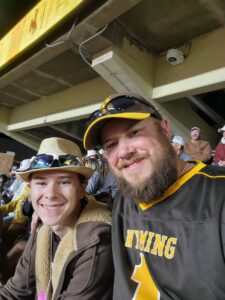
 the garage. It was a group effort, with help from brothers-in-law, Mike Reed and Mike Stevens, Ryan and his son, Ethan as well. The project was a great success, and the guys had a great time. Allyn tells me that, “Ryan was such a huge help for us this summer building the garage! He was faithful to come out and sacrifice his own time to give of himself. We appreciate so much his strength and can-do attitude! Chris loved the dad/son time, and their close relationship has grown even more and gotten stronger. He really enjoys spending time with Ryan!”
the garage. It was a group effort, with help from brothers-in-law, Mike Reed and Mike Stevens, Ryan and his son, Ethan as well. The project was a great success, and the guys had a great time. Allyn tells me that, “Ryan was such a huge help for us this summer building the garage! He was faithful to come out and sacrifice his own time to give of himself. We appreciate so much his strength and can-do attitude! Chris loved the dad/son time, and their close relationship has grown even more and gotten stronger. He really enjoys spending time with Ryan!”
The Hadlock family went camping some this year too. They went to the Big Horn Mountains a few times, and thankfully they were able to do that, because after the massive fire in the Big Horns that is going on right now, things may not be the same there for a while. Ryan and Ethan went to Top Golf for a father-son fun time. That was a lot a great time, and always an important thing for men and their boys. They also went camping in the Black Hills, and then, of course, there is the inevitable job of working on the camper.
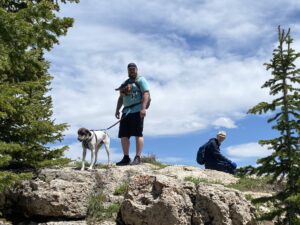
 They went to a concert last month, and another one is coming up next week! They’ve been to a few Wyoming Cowboys’ games this year too, which is a fun family time for the whole Hadlock clan. Ryan and Chris are going to a Broncos game in a couple of weeks, after attending another Cowboys’ game…an all sports weekend. Ryan and his family have been blessed to have a super good year, and they know that next year will be even better!! Today is Ryan’s birthday. Happy birthday Ryan!! Have a great day!! We love you!!
They went to a concert last month, and another one is coming up next week! They’ve been to a few Wyoming Cowboys’ games this year too, which is a fun family time for the whole Hadlock clan. Ryan and Chris are going to a Broncos game in a couple of weeks, after attending another Cowboys’ game…an all sports weekend. Ryan and his family have been blessed to have a super good year, and they know that next year will be even better!! Today is Ryan’s birthday. Happy birthday Ryan!! Have a great day!! We love you!!

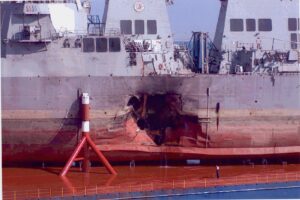 The USS Cole, an American naval destroyer, captained by Commander Kirk Lippold, arrived in Aden, Yemen at the southern end of the Arabian Peninsula for refueling, en route to join US warships enforcing trade sanctions against Iraq. At 12:15pm local time, a motorized rubber dinghy filled with explosives created a 40-by-40-foot hole in the port side of the ship, while it was docked for refueling in Aden. How could it have been that easy? The attack, which resulted in the death of seventeen sailors and wounded thirty-eight, was perpetrated by two suicide terrorists believed to be affiliated with Osama bin Laden’s al Qaeda network.
The USS Cole, an American naval destroyer, captained by Commander Kirk Lippold, arrived in Aden, Yemen at the southern end of the Arabian Peninsula for refueling, en route to join US warships enforcing trade sanctions against Iraq. At 12:15pm local time, a motorized rubber dinghy filled with explosives created a 40-by-40-foot hole in the port side of the ship, while it was docked for refueling in Aden. How could it have been that easy? The attack, which resulted in the death of seventeen sailors and wounded thirty-eight, was perpetrated by two suicide terrorists believed to be affiliated with Osama bin Laden’s al Qaeda network.
The blast resulted in significant flooding aboard the warship, causing it to list slightly. Nevertheless, by nightfall, the crew had successfully halted the water flooding in, thereby keeping the Cole afloat. Following the assault, President Bill Clinton directed US vessels in the Persian Gulf to evacuate the area and proceed to the open sea. He then dispatched large contingent of American investigators to Aden for a thorough inquiry. The group included FBI agents dedicated to probing potential connections to Osama bin Laden. Bin Laden had already been indicted in the United States for orchestrating the 1998 embassy bombings in Kenya and Tanzania, which claimed the lives of 224 individuals, among them 12 Americans, so it was not a far stretch to think he would have a hand in this attack too.
The USS Cole’s brief four-hour stopover indicates that the terrorists had inside information about its unscheduled visit to the Aden fueling station. The small boat used by the terrorists merged seamlessly with other harbor vessels aiding the Cole’s mooring process and managed to get close to the US warship undetected. Upon detonation of their dinghy, a substantial explosion ripped through the Cole’s port side, causing extensive damage to the engine room, mess hall, and living quarters. Witnesses aboard the Cole reported seeing both terrorists stand up moments before the blast, typical of suicide bombers.
In all, six individuals were suspected of involvement in the Cole attack. They were quickly detained in Yemen, but due to the lack of cooperation from Yemeni officials, the FBI has been unable to definitively connect the 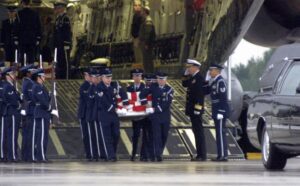
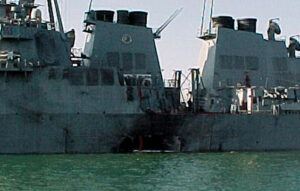 attack to bin Laden, even though we all know that he masterminded it. This kind of attack was so typical of the type of attack that would later make bin Laden well known as a major player in attacks against American targets. As for Americans, these leaks and the inability of the FBI to resolve the issue are some of the biggest reasons that many Americans don’t trust the FBI today.
attack to bin Laden, even though we all know that he masterminded it. This kind of attack was so typical of the type of attack that would later make bin Laden well known as a major player in attacks against American targets. As for Americans, these leaks and the inability of the FBI to resolve the issue are some of the biggest reasons that many Americans don’t trust the FBI today.

 My nephew, Riley Birky has had a rough year. Not like most people think of a rough year. He has had a really rough year. It started out good, but on July 4th, everything changed…everything. Riley; his little brother, Tucker Schulenberg; and a couple of friends, Landon and Dylan; had gone to pick up fireworks for the evening’s festivities. Little is known about wat happened from there, but it is suspected that someone lit a cigarette without thinking about the fireworks. Seconds later, the car was engulfed in flames. I read where they are crediting Riley with the saving of lives and preventing an accident, In the midst of driving a car that burst into flames, Riley had the presence of mind to pull over, even though he was being burned. He stopped safely and them assisted the other boys, so that all got out alive. Riley was a hero.
My nephew, Riley Birky has had a rough year. Not like most people think of a rough year. He has had a really rough year. It started out good, but on July 4th, everything changed…everything. Riley; his little brother, Tucker Schulenberg; and a couple of friends, Landon and Dylan; had gone to pick up fireworks for the evening’s festivities. Little is known about wat happened from there, but it is suspected that someone lit a cigarette without thinking about the fireworks. Seconds later, the car was engulfed in flames. I read where they are crediting Riley with the saving of lives and preventing an accident, In the midst of driving a car that burst into flames, Riley had the presence of mind to pull over, even though he was being burned. He stopped safely and them assisted the other boys, so that all got out alive. Riley was a hero. 

The boys were taken to the hospital and quickly flown to Denver, where they remained for varying lengths of time, as each on had different burns. While the struggle to recover has really hard, Riley persevered and is now back home, as are the three other boys. Their story truly is a miracle. These young men were so close to death, but they had people who were praying for them. God is so good. These days all the boys are home, Tucker is back to school, and while Riley isn’t back to work yet, he is doing really well.
Riley is a great dad to his son Ryder and bonus son, Jace. He is a great fiancé to his fiancée, Sierah Martin, and he is a great brother to Tucker. His presence in their lives is not only important…it’s vital. They rely on him so much, and Riley has stepped up to be the man they need him to be. He didn’t have to be this kind of man, but 
 Riley has proven himself to be just exactly that…a step up when needed kind of man!! I am so roud of the man Riley has become, and I know that he will continue to make his family proud.
Riley has proven himself to be just exactly that…a step up when needed kind of man!! I am so roud of the man Riley has become, and I know that he will continue to make his family proud.
Riley has a long way to go in his recovery, as do Tucker, Landon, and Dylan. The boys were all blessed in that their faces were not scarred. Nevertheless, their arms and legs will have a long road to recovery. Still, these boys are fighters, and they have many people praying for them behind the scenes. I know they will recover well and lead amazing lives. Today is Riley’s 24th birthday. Happy birthday Riley!! Have a great day!! We love you!!
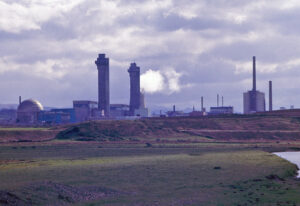 Sellafield, which was formerly known as Windscale Works, was an important multi-functional nuclear site located near Seascale on the coast of Cumbria, England. As of August 2022, its primary activities are the processing and storage of nuclear waste, along with decommissioning. Historically, the facility produced nuclear power from 1956 to 2003 and reprocessed nuclear fuel from 1952 to 2022. Originally built as a Royal Ordnance Factory in 1942, the site was briefly owned by Courtaulds for rayon production in the post-World War II years. Then in 1947, the Ministry of Supply reacquired it for plutonium production, leading to the construction of the Windscale Piles and the First-Generation Reprocessing Plant, and its renaming to “Windscale Works.” Significant developments followed, including the construction of Calder Hall, the world’s first commercial nuclear power station to supply electricity to a public grid, the Magnox fuel reprocessing plant, the prototype Advanced Gas-cooled Reactor (AGR), and the Thermal Oxide Reprocessing Plant (THORP). Decommissioning has been concentrated on the Windscale Piles, Calder Hall, and various historic reprocessing and waste storage facilities.
Sellafield, which was formerly known as Windscale Works, was an important multi-functional nuclear site located near Seascale on the coast of Cumbria, England. As of August 2022, its primary activities are the processing and storage of nuclear waste, along with decommissioning. Historically, the facility produced nuclear power from 1956 to 2003 and reprocessed nuclear fuel from 1952 to 2022. Originally built as a Royal Ordnance Factory in 1942, the site was briefly owned by Courtaulds for rayon production in the post-World War II years. Then in 1947, the Ministry of Supply reacquired it for plutonium production, leading to the construction of the Windscale Piles and the First-Generation Reprocessing Plant, and its renaming to “Windscale Works.” Significant developments followed, including the construction of Calder Hall, the world’s first commercial nuclear power station to supply electricity to a public grid, the Magnox fuel reprocessing plant, the prototype Advanced Gas-cooled Reactor (AGR), and the Thermal Oxide Reprocessing Plant (THORP). Decommissioning has been concentrated on the Windscale Piles, Calder Hall, and various historic reprocessing and waste storage facilities.
During its “Windscale Works” years, a severe fire broke out in the core of a nuclear reactor on October 10, 1957. As a result, significant radioactive material was released into the environment on October 10-11, 1957. Windscale Works was under the operation of the United Kingdom Atomic Energy Authority (UKAEA) at the time. On the 15th of October, the UKAEA Chairman announced the formation of an Inquiry Committee, chaired by Sir William Penney, to investigate the incident. The Committee convened at  Windscale Works from October 17–25th. They interviewed 37 individuals and reviewed 73 technical exhibits. They submitted their findings to the UKAEA Chairman on 26th October. These findings underpinned a UK Government White Paper (Command Paper 302), published on November 8, 1957. Oddly or perhaps criminally, the Penney Report itself remained unpublished until it was made available at The National Archives, Kew, in January 1988, basically covering up the event for decades. This event transpired when uranium metal fuel caught fire within Windscale Pile No. 1. The fire led to the release of radioactive contamination into the environment, which is estimated to have eventually caused approximately 240 cancer cases, with fatalities between 100 to 240. The incident received a level 5, on the International Nuclear Event Scale. The maximum rating is 7.
Windscale Works from October 17–25th. They interviewed 37 individuals and reviewed 73 technical exhibits. They submitted their findings to the UKAEA Chairman on 26th October. These findings underpinned a UK Government White Paper (Command Paper 302), published on November 8, 1957. Oddly or perhaps criminally, the Penney Report itself remained unpublished until it was made available at The National Archives, Kew, in January 1988, basically covering up the event for decades. This event transpired when uranium metal fuel caught fire within Windscale Pile No. 1. The fire led to the release of radioactive contamination into the environment, which is estimated to have eventually caused approximately 240 cancer cases, with fatalities between 100 to 240. The incident received a level 5, on the International Nuclear Event Scale. The maximum rating is 7.
Now called Sellafield, the licensed premises span 650 acres, housing over 200 nuclear facilities and more than 1,000 buildings. It stands as the largest nuclear site in Europe, boasting the world’s most varied array of nuclear facilities on a single site. Workforce numbers fluctuate, but prior to the COVID-19 pandemic, the site 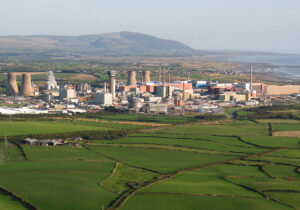 employed around 10,000 individuals. The Central Laboratory and headquarters of the UK’s National Nuclear Laboratory are located on the premises. The site is owned by the Nuclear Decommissioning Authority (NDA), a non-departmental public body of the UK government. From 2008 to 2016, it was managed by a private consortium before control reverted to the government. Consequently, the Site Management Company, Sellafield Ltd, became a subsidiary of the NDA. The decommissioning process of the legacy facilities, which includes structures from the UK’s early efforts to develop an atomic bomb, is expected to be completed by 2120 at an estimated cost of £121 billion.
employed around 10,000 individuals. The Central Laboratory and headquarters of the UK’s National Nuclear Laboratory are located on the premises. The site is owned by the Nuclear Decommissioning Authority (NDA), a non-departmental public body of the UK government. From 2008 to 2016, it was managed by a private consortium before control reverted to the government. Consequently, the Site Management Company, Sellafield Ltd, became a subsidiary of the NDA. The decommissioning process of the legacy facilities, which includes structures from the UK’s early efforts to develop an atomic bomb, is expected to be completed by 2120 at an estimated cost of £121 billion.
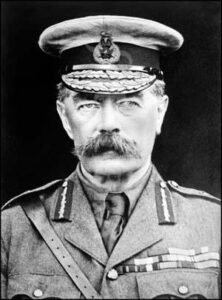
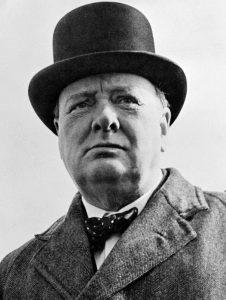 The initiative to send a relief army to support Antwerp did not begin with Winston Churchill, but with Lord Kitchener and the French Government. Churchill was not involved or consulted about the plans until they were well underway, with significant troop movements already in progress or planned. Deciding that he should be brought into the loop, Churchill was summoned to a midnight meeting at Lord Kitchener’s residence on October 2, 1914. It was during this meeting that he fully grasped the progress of the plans to send a relief army to Antwerp, a coordination between Lord Kitchener and the French Government. He learned as well that no definitive commitments had been made to the Belgian Government. On that same afternoon, the Belgian Government had resolved to evacuate Antwerp, pull back the field army from the fort, and effectively abandon the city’s defense.
The initiative to send a relief army to support Antwerp did not begin with Winston Churchill, but with Lord Kitchener and the French Government. Churchill was not involved or consulted about the plans until they were well underway, with significant troop movements already in progress or planned. Deciding that he should be brought into the loop, Churchill was summoned to a midnight meeting at Lord Kitchener’s residence on October 2, 1914. It was during this meeting that he fully grasped the progress of the plans to send a relief army to Antwerp, a coordination between Lord Kitchener and the French Government. He learned as well that no definitive commitments had been made to the Belgian Government. On that same afternoon, the Belgian Government had resolved to evacuate Antwerp, pull back the field army from the fort, and effectively abandon the city’s defense.
The men were deeply troubled by the Belgian Government’s plan. It appeared that just as help was within reach, everything might be sacrificed for a mere three or four days of further resistance. Under these conditions, Churchill proposed to immediately travel to Antwerp to inform the Belgian Government of the ongoing efforts, assess the situation firsthand, and explore how the defense could be extended until a relief force was ready. The others agreed to Churchill’s proposal, and he promptly made his way across the Channel.
The next day, after discussions with the Belgian Government and British Staff officers in Antwerp overseeing the operations, Churchill presented a cautious telegraphic proposal. He avoided any declarations on behalf of the British Government that might encourage the Belgians to hold out for support he couldn’t guaranteed.
Churchill’s proposal was concise and transmitted via telegram. It stated: “The Belgians were to continue the resistance to the utmost limit of their power. The British and French Governments were to say within three days definitely whether they could send a relieving force or not, and what the dimensions of that force would be.
In the event of their not being able to send a relieving force the British Government were to send in any case to Ghent and other points on the line of retreat British troops sufficient to insure the safe retirement of the Belgian field army, so that the Belgian  field army would not be compromised through continuing the resistance on the Antwerp fortress line.
field army would not be compromised through continuing the resistance on the Antwerp fortress line.
Incidentally, we were to aid and encourage the defense of Antwerp by the sending of naval guns, naval brigades, and any other minor measures likely to enable the defenders to hold out the necessary number of days.”
The proposal was contingent upon approval from both parties. It remained unsettled until it received the acceptance of both governments. Upon agreement, Churchill received a telegraph announcing the dispatch of a relief army, including its size and structure, which I was to communicate to the Belgians. Churchill was instructed to do all in his power to sustain the defense in the interim, which he did, disregarding any potential repercussions.
Churchill chose not to recount the well-known military events, but he believed it would be erroneous to view Lord Kitchener’s attempts to relieve Antwerp, in which Churchill had a significant but secondary role, as a venture that resulted solely in adversity.
Churchill believed that military history would deem the outcomes highly favorable to the Western Allies. The significant battle that began on the Aisne was extending daily towards the sea. Sir John French’s forces were assembling and commencing the Battle of Armentières, which led to the pivotal Battle of Ypres, amid an ever-changing situation.
The prolonged defense of Antwerp, even by just a few days, detained substantial German forces near the fortress. The sudden and audacious deployment of a new British division and a British cavalry division at Ghent, among other places, perplexed the cautious German command, causing them to anticipate the arrival of a large force from the sea.
Regardless, their advance was tentative, faced with only weak opposition, and Churchill was convinced that history would confirm, certainly in his view and that of many esteemed military officers of the time, that the 
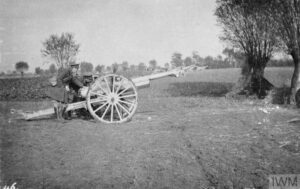 entirety of this operation…the movement of the British and associated French troops…though it failed to save Antwerp, resulted in the great battle being fought along the Yser, rather than twenty or thirty miles to the south, and if that was the case, then the losses sustained by the naval division, fortunately not severe in terms of lives, will undoubtedly have been justified for the greater good.
entirety of this operation…the movement of the British and associated French troops…though it failed to save Antwerp, resulted in the great battle being fought along the Yser, rather than twenty or thirty miles to the south, and if that was the case, then the losses sustained by the naval division, fortunately not severe in terms of lives, will undoubtedly have been justified for the greater good.
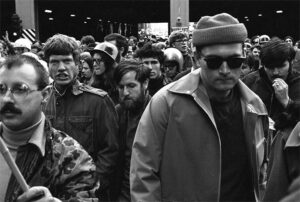
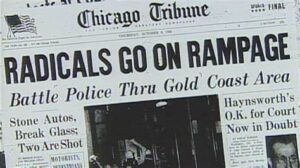 In the late 1960s, Chicago was engulfed in turmoil. The assassination of Martin Luther King Jr. on April 4, 1968, sparked riots throughout the United States, leaving Chicago’s West Side in ruins. Mayor Richard J Daley infamously ordered a “shoot to kill” directive for arsonists. It was a vast difference from the way riots were handled in the 2020 era, after the killing of George Floyd, when riots were not only allowed, but encouraged. Nevertheless, in Chicago in 1968, chaos reigned then and again during the Democratic National Convention a few months later, culminating in a confrontation between protesters and police that a national commission later described as a “police riot.”
In the late 1960s, Chicago was engulfed in turmoil. The assassination of Martin Luther King Jr. on April 4, 1968, sparked riots throughout the United States, leaving Chicago’s West Side in ruins. Mayor Richard J Daley infamously ordered a “shoot to kill” directive for arsonists. It was a vast difference from the way riots were handled in the 2020 era, after the killing of George Floyd, when riots were not only allowed, but encouraged. Nevertheless, in Chicago in 1968, chaos reigned then and again during the Democratic National Convention a few months later, culminating in a confrontation between protesters and police that a national commission later described as a “police riot.”
The year 1969 seemed to mark a period of calm until the commencement of a conspiracy trial targeting the Democratic convention protest organizers, which ignited a new phase in the clash between the counterculture and the “establishment.” This battle shifted from the streets to the realm of public opinion. While the defendants attempted to mock and censure the government, represented by Judge Julius Hoffman in the courtroom, a separate faction of youth chose to take a more extreme stance in protesting the government and the ongoing Vietnam conflict. Their strategy was to “bring the war home” through four “Days of Rage.” It amazes me that these people think that destroying their own “home turf” and the businesses that are there, would somehow generate support for their cause…and then they want the American people to pay for the repairs!!
“Every day that the war [in Vietnam] went on, two thousand innocent people would be killed. So, there was a kind of urgency that took over. And in that context, we faced each other and tried to figure out, what do you do to end a war? How do you stop it,” Bill Ayers, an organizer of the Days of Rage, told WTTW decades later. Ayers and his fellow protesters belonged to the activist group Students for a Democratic Society but were starting to diverge from the main SDS body. They named themselves the Weathermen, inspired by a lyric in a Bob Dylan song, “Subterranean Homesick Blues” which stated, “You don’t need a weather man to know which way the wind blows.”
The Weathermen believed that the peaceful methods of other SDS factions were ineffective, so they organized for thousands to converge on Chicago, coinciding with the commencement of the Chicago Eight conspiracy trial two weeks later. “A huge outpouring of militance, of young people. We felt that we ought to call a demonstration in which we weren’t contained and controlled,” Ayers said. However, as the Days of Rage commenced, the Weathermen discovered their support was significantly less than anticipated. On October 8, 1969, they assembled in Lincoln Park to initiate their violent protests—donning football helmets and shoulder pads, and arming themselves with steel pipes, chains, slingshots, and baseball bats—yet only a few hundred individuals participated, a stark contrast to the fifty thousand they had expected.
On that initial evening in 1969, protesters headed south toward the Drake Hotel, the residence of Judge Hoffman, shattering the windows of vehicles and shops in their path. Following their assault on police barricades, law enforcement quelled the disturbances with countermeasures, deploying tear gas, nightsticks, and firearms. Although some Weathermen were shot and officers sustained injuries, there were no fatalities. “The thought of the Chicago Police Department and the mayor of the city of Chicago was to try to avoid confrontation,” Richard Elrod, a state legislator and attorney for the city who had been tasked with handling the riots, told WTTW decades later. Ayers disagreed, saying, “I don’t think the police, or the city learned a thing between ’68 and ’69.” The police faced widespread criticism for their management of the protests at the Democratic convention the previous year.
Other activists criticized the tactics of the Weathermen. “We thought it was off the wall,” Carl Davidson, a leader of SDS, told WTTW. “We thought it was silly, counterproductive, that it wasn’t going anywhere. That’s the best we thought of it.” A different branch of SDS coordinated peaceful protests with the Black Panthers against the Vietnam War and persistent racial inequality, attracting thousands of participants. However, it was the minor yet violent actions of the Weathermen that captured media attention. Even Ayers later expressed doubt about the riots, saying “I don’t think that the Days of Rage was a particularly smart or effective tactic. I think it was a very difficult time to know what to do, but we were determined to see through our strategy of militant opposition and trying to mobilize all of the militants to come to Chicago to display their anger, their outrage, and their deep opposition to this war. That was a colossal failure, in the sense that we didn’t mobilize lots of people to come.”
The subsequent Days of Rage were less intense, yet on October 11, the Weathermen gathered at a statue of a policeman they had previously bombed in the lead-up to the Days of Rage and proceeded into the Loop. They once again engaged with the police, an event described in a 1994 retrospective article by the Chicago Tribune as a “vicious melee that resulted in nearly 300 arrests, 48 police injuries and unknown more to protesters.” In the midst of the confrontation, Richard Elrod sustained a neck injury that resulted in paralysis from the neck down, although he later regained some movement but continued to suffer partial paralysis. Elrod reported that he had attempted to tackle Brian Flanagan, a 22-year-old protester, who retaliated by kicking him in the neck with steel-toed boots. Flanagan, who was ultimately acquitted on all counts, contended that Elrod collided with a concrete wall during his attempted tackle. The subsequent year, Elrod was elected as the Cook County sheriff and subsequently ascended to the position of a Circuit Court judge.
Former state legislator and Cook County sheriff Richard Elrod, who is shown in a photo from the early 2000s, suffered a broken neck during the Days of Rage. That confrontation marked the end of the Days of Rage. The Weathermen, in certain respects, “brought the war home.” However, their protests might have inadvertently enhanced the police’s reputation and undermined the causes they supported by linking anti-war and anti-racism demonstrations with violence in public perception. Following the Days of Rage, a lengthy magazine feature overtly supportive of the police and the city appeared in the Chicago Tribune, which asserted that “the police, widely condemned scarcely a year ago for their conduct during the Democratic convention, had never enjoyed so much public acclaim.”
Months later, the Weathermen were forced underground when a bomb they were constructing inadvertently detonated, killing three of their leaders in New York City. In the following decades, participants of the Days of Rage began to turn themselves in to the authorities. One of the last to do so was Jeffrey David Powell, who surrendered in 1994 and was sentenced to a fine and 18 months of probation. Ayers, along with his wife Bernardine Dohrn, another member of the Weathermen, surrendered in 1981. While Dohrn was fined and placed on probation, charges against Ayers, whose father was a president at Commonwealth Edison, were dismissed due to illicit FBI methods used against him. He went on to become a professor at the University of Illinois at Chicago and gained brief national attention during the 2008 presidential election for his association with Barack Obama. Dohrn secured a position as a professor at the Children and Family Justice Center at Northwestern University’s Law School. 
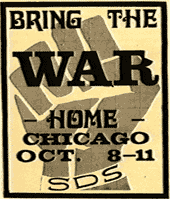
The Days of Rage had receded into the annals of history. However, as reported by the Chicago Tribune at the time of Powell’s surrender, “the Days of Rage symbolized a marked fissure in American society, the end of the carefree ‘60s, when rich, white college kids clashed with police, their parents, the government in protest against the Vietnam War, racial intolerance and just about everything else that had served as the status quo.”
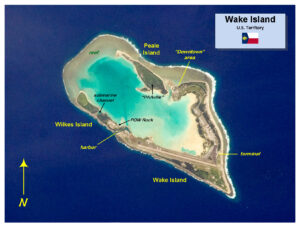
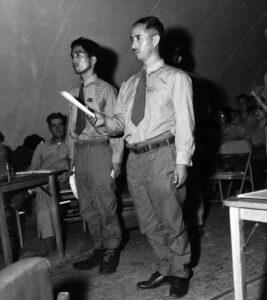 The Battle of Wake Island was a significant conflict in the Pacific theater of World War II, occurring on Wake Island. The attack began simultaneously with the assault on Pearl Harbor’s naval and air bases in Hawaii on the morning of December 8, 1941 (December 7th in Hawaii) and concluded on December 23rd with the American forces capitulating to the Empire of Japan. The battle took place on the atoll comprising Wake Island and its smaller islets, Peale and Wilkes, involving air, land, and sea forces of the Japanese Empire and the United States, with a notable presence of Marines from both nations. The Japanese forces were formidable, and the majority of the surviving Americans were transported from the island to POW camps by the Japanese. Ninety-seven were left behind to be used as forced labor. The Allies’ response involved intermittent bombing of the island, but no further land invasions occurred. This was in line with a broader Allied strategy to isolate certain Japanese-occupied islands in the South Pacific, effectively leaving them to wither in isolation.
The Battle of Wake Island was a significant conflict in the Pacific theater of World War II, occurring on Wake Island. The attack began simultaneously with the assault on Pearl Harbor’s naval and air bases in Hawaii on the morning of December 8, 1941 (December 7th in Hawaii) and concluded on December 23rd with the American forces capitulating to the Empire of Japan. The battle took place on the atoll comprising Wake Island and its smaller islets, Peale and Wilkes, involving air, land, and sea forces of the Japanese Empire and the United States, with a notable presence of Marines from both nations. The Japanese forces were formidable, and the majority of the surviving Americans were transported from the island to POW camps by the Japanese. Ninety-seven were left behind to be used as forced labor. The Allies’ response involved intermittent bombing of the island, but no further land invasions occurred. This was in line with a broader Allied strategy to isolate certain Japanese-occupied islands in the South Pacific, effectively leaving them to wither in isolation.
On October 5, 1943, American naval aircraft from the USS Yorktown attacked Wake Island. On October 7, 1943, Rear Admiral Shigematsu Sakaibara, commander of the Japanese garrison on the island, orders the execution of a civilian accused of stealing, and 97 Americans POWs, claiming they were trying to make radio contact with US forces, and a civilian accused of stealing. Initially, the 97 POWs were detained to be used as forced labor. Anticipating an invasion, Sakaibara commanded their execution. They were led to the island’s northern end, blindfolded, and shot with a machine gun. One prisoner, whose name remains unknown, escaped and etched “98 US PW 5-10-43” into a large coral rock near the hastily dug mass grave. This American was later recaptured, and Sakaibara personally beheaded him with a katana. The etched message remains visible, marking a somber landmark on Wake Island to this day. The Wake Island Massacre was an outrage.
The Pacific war finally drew to a close starting in August 1945, and the Emperor of Japan announced the surrender to the Japanese people and the agreement was formally signed by September 2, 1945. On September 4, 1945, the remaining Japanese garrison surrendered to a detachment of United States Marines under the command of Brigadier General Lawson H. M. Sanderson, with the handover being officially conducted in a brief ceremony aboard the destroyer escort USS Levy. Earlier, the garrison received news that Imperial Japan’s defeat was imminent, so the mass grave was quickly exhumed, and the bones were moved to the US cemetery that had been established on Peacock Point after the invasion, with wooden crosses erected in preparation for the expected arrival of US forces. During the initial interrogations, the Japanese claimed that the remaining 98 Americans on the island were mostly killed by an American bombing raid, though some escaped and fought to the death after being cornered on the beach at the north end of Wake Island. Several Japanese officers in American custody committed suicide over the incident, leaving written statements that incriminated Sakaibara. Sakaibara and his subordinate, Lieutenant Commander Tachibana, were later sentenced 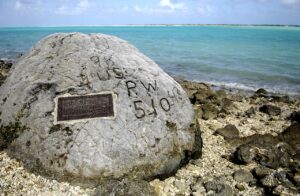
 to death after conviction for this and other war crimes. Sakaibara was executed by hanging in Guam on June 19, 1947, while Tachibana’s sentence was commuted to life in prison. The remains of the murdered civilians were exhumed and reburied at Section G of the National Memorial Cemetery of the Pacific, which is commonly known as Punchbowl Crater, on Honolulu.
to death after conviction for this and other war crimes. Sakaibara was executed by hanging in Guam on June 19, 1947, while Tachibana’s sentence was commuted to life in prison. The remains of the murdered civilians were exhumed and reburied at Section G of the National Memorial Cemetery of the Pacific, which is commonly known as Punchbowl Crater, on Honolulu.
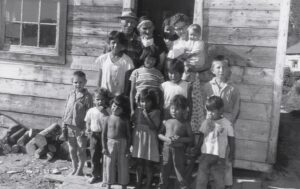
 The Sixties Scoop, often referred to simply as The Scoop, was a time when policies in Canada allowed child welfare authorities to remove Indigenous children from their families and communities to place them in foster homes. These children were then adopted by white families. Although it is called the Sixties Scoop, this practice started in the mid-to-late 1950s and continued until the 1980s. There was no given indication that these children were neglected or mistreated, just that they were Indigenous, and supposedly, therefore would be better off in the care of white families. During those years, an estimated 20,000 Indigenous children were removed from their families and placed predominantly with white middle-class families.
The Sixties Scoop, often referred to simply as The Scoop, was a time when policies in Canada allowed child welfare authorities to remove Indigenous children from their families and communities to place them in foster homes. These children were then adopted by white families. Although it is called the Sixties Scoop, this practice started in the mid-to-late 1950s and continued until the 1980s. There was no given indication that these children were neglected or mistreated, just that they were Indigenous, and supposedly, therefore would be better off in the care of white families. During those years, an estimated 20,000 Indigenous children were removed from their families and placed predominantly with white middle-class families.
The program’s policies were not uniform, with each province implementing distinct foster programs and adoption policies. Saskatchewan was unique in having the targeted Indigenous transracial adoption program known as the Adopt Indian Métis (AIM) Program. The term “Sixties Scoop” was first used in the early 1980s by social workers from the British Columbia Department of Social Welfare to describe the practice of child apprehension by their department. This term made its initial appearance in print in a 1983 report by the Canadian Council on Social Development, entitled “Native Children and the Child Welfare System.” Researcher Patrick Johnston cited the term’s origin and utilized it in his report. This term is akin to “Baby Scoop Era,” denoting the time from the late 1950s to the 1980s when many children were removed from unmarried mothers for adoption. These mothers were given no choice in the matter.
The government policies responsible for the Sixties Scoop were abandoned in the mid-1980s following resolutions passed by Ontario chiefs and severe condemnation from a Manitoba judicial inquiry. The inquiry, led by Associate Chief Judge Edwin C. Kimelman, culminated in the release of “No Quiet Place / Review Committee on Indian and Métis Adoptions and Placements,” commonly referred to as the “Kimelman Report.” Numerous lawsuits have been initiated in Canada by individuals who were part of the Sixties Scoop, including class-action suits in five provinces, such as the one initiated in British Columbia in 2011. Chief Marcia Brown Martel of the Beaverhouse First Nation was the lead plaintiff in the Ontario class-action suit filed in 2009. On February 14, 2017, Justice Edward Belobaba of the Ontario Superior Court found the government responsible for damages caused by the Sixties Scoop. Subsequently, on October 6, 2017, an $800-million settlement was disclosed for the Martel case. Currently, Métis and non-status First Nations individuals are not included in the settlement, prompting the National Indigenous Survivors of Child Welfare Network…an organization led by survivors of the Sixties Scoop in Ottawa…to call for the rejection of the settlement unless it encompasses all Indigenous individuals who were removed from their homes and placed into forced adoption.
The Sixties Scoop began during a period when Indigenous families were already grappling with the consequences of the Canadian Indian residential school system. This network of boarding schools for Indigenous peoples adversely affected their social, economic, and living conditions. The residential school system remained operational until the closure of the last school in 1996. Established by the federal government and managed by various churches, the system’s goal was to assimilate Aboriginal children by teaching them Euro-Canadian and Christian values. It enforced policies that prohibited the children from speaking their native languages, communicating with their families, or practicing their cultural traditions. Survivors of residential schools have spoken out about the physical, spiritual, sexual, and psychological abuse they endured from the staff. The enduring cultural impact on First Nations, Métis, and Inuit families and communities is both widespread and profound.
The Sixties Scoop involved the forced removal of children from their Indigenous lands and communities, often without the consent or knowledge of their families or tribes. Siblings were frequently separated and sent to different areas to prevent any communication with their relatives. These children were denied knowledge of their true nationality, history, or family ties. If a child sought to learn about their cultural identity, they required consent from their biological parents. However, due to the government’s efforts to sever ties between the children and their biological families, access to their birth records was impossible. Consequently, while the children might have suspected their cultural heritage, they had no means to verify it with concrete evidence.
The Canadian government began the process of closing the mandatory residential school system in the 1950s and 1960s, believing that Aboriginal children would receive a superior education within the public school system. A summary states: “This transition to provincial services led to a 1951 [Indian Act] amendment that enabled the province to provide services to Aboriginal people where none existed federally. Child protection was one of these areas. In 1951, twenty-nine Aboriginal children were in provincial care in British Columbia; by 1964, that number was 1,466. Aboriginal children, who had comprised only 1 percent of all children in care, came to make up just over 34 percent.”
The Truth and Reconciliation Commission (TRC) of Canada, established as part of the Indian Residential Schools Settlement Agreement, was tasked with recording the experiences of Indigenous children in residential schools. Its mission was to disseminate the truths of survivors, their families, communities, and all those impacted, to the Canadian populace. The TRC’s final report, released in 2015, details these findings: “By the end of the 1970s, the transfer of children from residential schools was nearly complete in Southern Canada, and the impact of the Sixties Scoop was in evidence across the country.” First Nations have persistently resisted such policies through various means, including legal challenges (Natural Parents v. Superintendent of Child Welfare, 1976, 60 D.L.R. 3rd 148 S.C.C) and the establishment of their own policies, like the Spallumcheen Indian Band’s by-law to manage its child welfare program, achieving varying levels of success.
In response to the loss of their children and the subsequent cultural genocide, First Nations communities took 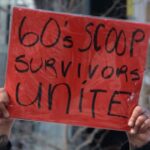
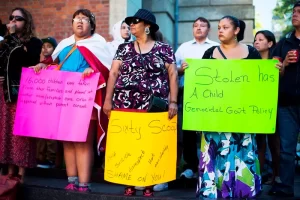 action by repatriating children from failed adoptions and striving to reclaim authority over their children’s welfare practices. This movement began in 1973 with the Blackfoot (Siksika) child welfare agreement in Alberta. Currently, there are approximately 125 First Nations Child and Family Service Agencies in Canada, operating under a variety of agreements that grant them authority from provincial governments to offer services, with funding provided by the federal government.
action by repatriating children from failed adoptions and striving to reclaim authority over their children’s welfare practices. This movement began in 1973 with the Blackfoot (Siksika) child welfare agreement in Alberta. Currently, there are approximately 125 First Nations Child and Family Service Agencies in Canada, operating under a variety of agreements that grant them authority from provincial governments to offer services, with funding provided by the federal government.

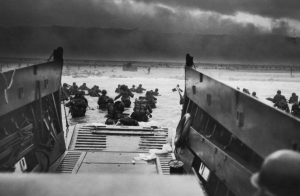 My uncle, Lester “Jim” Wolfe was in the Army during World War II, and as such, was among those who stormed the beaches of Normandy, France on D-Day (June 6, 1944), while my dad, Allen Spencer, his future brother-in-law, was among the B-17s flying cover in the skies above. Thankfully, both of them made it home, and became the men they were destined to be. I really can’t imagine growing up without knowing my Uncle Jim. He was a great guy, with a great sense of humor. He saw a lot of things in his lifetime, and so, he always had great stories to tell. To my child’s mind, my uncle seemed very knowledgeable in things, as did my dad. It was a different era than that of my own, and they knew different things as a result. I guess that is why they always seemed so wise to me.
My uncle, Lester “Jim” Wolfe was in the Army during World War II, and as such, was among those who stormed the beaches of Normandy, France on D-Day (June 6, 1944), while my dad, Allen Spencer, his future brother-in-law, was among the B-17s flying cover in the skies above. Thankfully, both of them made it home, and became the men they were destined to be. I really can’t imagine growing up without knowing my Uncle Jim. He was a great guy, with a great sense of humor. He saw a lot of things in his lifetime, and so, he always had great stories to tell. To my child’s mind, my uncle seemed very knowledgeable in things, as did my dad. It was a different era than that of my own, and they knew different things as a result. I guess that is why they always seemed so wise to me.
While he had a lot of wisdom, Uncle Jim was also a great comedian too. He was always making jokes and loved 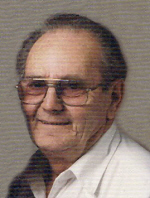 to make and hear people laugh. Uncle Jim was a master storyteller, the finest there was. Whenever he began his tales, we’d gather around, eyes wide with amazement. It was always a mystery whether his stories were drawn from life or were pre fiction…until the punchline came. At that moment, we’d burst into laughter, exclaiming, “Oh! Uncle Jim!” He delighted in our reactions, which brought him great amusement. And on the topic of amusement, Uncle Jim was an old hand at tickling. He’d chase and tickle us whenever we pestered him…which, of course, meant we always did. We’d scamper off, trying to escape, though we never really did. Uncle Jim’s heart was as kind as his spirit was playful.
to make and hear people laugh. Uncle Jim was a master storyteller, the finest there was. Whenever he began his tales, we’d gather around, eyes wide with amazement. It was always a mystery whether his stories were drawn from life or were pre fiction…until the punchline came. At that moment, we’d burst into laughter, exclaiming, “Oh! Uncle Jim!” He delighted in our reactions, which brought him great amusement. And on the topic of amusement, Uncle Jim was an old hand at tickling. He’d chase and tickle us whenever we pestered him…which, of course, meant we always did. We’d scamper off, trying to escape, though we never really did. Uncle Jim’s heart was as kind as his spirit was playful.
Uncle Jim was the kind of person who would help anyone in need, whether they were neighbors, friends, or even strangers. His generosity knew no bounds, and he was always ready to offer his assistance. His love for his family was his “above all” priority. He would protect his wife and children at all costs, both in words and actions. He was utterly devoted to them. When he decided to purchase land in Washington to build his final home, he ensured there was enough space for each of his children to have a place of their own nearby. He was determined that none of them would ever be without a home. The property he chose was atop a mountain, offering some of the most stunning views during the ascent. Even in his later years, as Alzheimer’s Disease necessitated his stay in a nursing home, he maintained his happy spirit. He delighted in brightening the day of the nursing staff and 
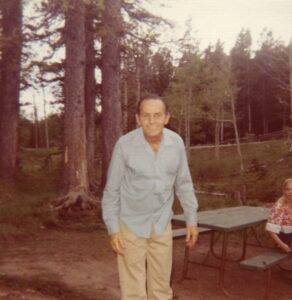 visitors alike, often engaging in harmless “mischief” around the nurses’ station. My sisters and I continue to hold him dear in our hearts. Thoughts of him always bring smiles to our faces. Uncle Jim passed away in 2013, reuniting with his beloved wife, my Aunt Ruth, and other departed family members. We’re comforted by the belief that they’re joyfully together, and we look forward to the day we’ll all be reunited. Today marks what would have been Uncle Jim’s 103rd birthday. Happy birthday in Heaven, Uncle Jim!! We love and miss you very much!!
visitors alike, often engaging in harmless “mischief” around the nurses’ station. My sisters and I continue to hold him dear in our hearts. Thoughts of him always bring smiles to our faces. Uncle Jim passed away in 2013, reuniting with his beloved wife, my Aunt Ruth, and other departed family members. We’re comforted by the belief that they’re joyfully together, and we look forward to the day we’ll all be reunited. Today marks what would have been Uncle Jim’s 103rd birthday. Happy birthday in Heaven, Uncle Jim!! We love and miss you very much!!
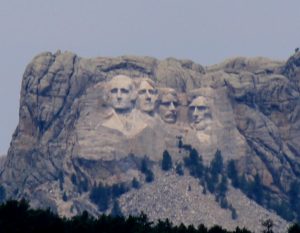
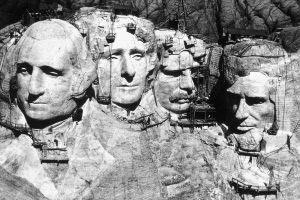 One of the most iconic monuments in the United States, in my opinion is that of Mount Rushmore. I’m sure some people might not agree with me on that, but I have been to Mount Rushmore more times than I could possibly count, and it just never gets old. The monument was the vision of Doane Robinson, a South Dakota historian who was looking to draw more visitors to the state. While that was a cool idea, it was dwarfed, in the end, by the absolute grandeur of the finished product. Maybe it was the vision of the sculptor, Gutzon Borglum, who Robinson commissioned to chisel the faces into the mountain, or maybe it was because it would transform a mountain into an awesome tribute to four really great presidents. I can’t say for sure, but the monument ended up being so much more than a tourist attraction. Every time I am there, I feel the awesomeness of the place, almost as if it is hallowed ground…though not in the Biblical sense.
One of the most iconic monuments in the United States, in my opinion is that of Mount Rushmore. I’m sure some people might not agree with me on that, but I have been to Mount Rushmore more times than I could possibly count, and it just never gets old. The monument was the vision of Doane Robinson, a South Dakota historian who was looking to draw more visitors to the state. While that was a cool idea, it was dwarfed, in the end, by the absolute grandeur of the finished product. Maybe it was the vision of the sculptor, Gutzon Borglum, who Robinson commissioned to chisel the faces into the mountain, or maybe it was because it would transform a mountain into an awesome tribute to four really great presidents. I can’t say for sure, but the monument ended up being so much more than a tourist attraction. Every time I am there, I feel the awesomeness of the place, almost as if it is hallowed ground…though not in the Biblical sense.
The sculpting of Mount Rushmore was a monumental task, particularly in 1927. Nevertheless, the carving began on October 4th on the likenesses of the four great men of Mount Rushmore, located in the Black Hills National Forest of South Dakota. The project was to be far from quickly finished. Instead, it would take an additional 12 years to complete the granite likenesses of four esteemed American presidents…George Washington, Thomas Jefferson, Abraham Lincoln, and Theodore Roosevelt. Each time a likeness was completed, it was big news, and people came from miles around to watch the unveiling ceremony. Of course, the project was not without conflict. The Lakota Sioux people, who consider the Black Hills to be sacred ground, strongly opposed the project. The mountain was previously part of the Great Sioux Reservation before being taken away 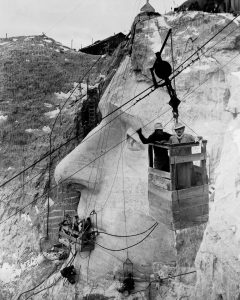 from them by the US government. Nevertheless, there were no skirmishes over the project, and these days, the likeness of Crazy Horse is also being carved into a mountain in the Black Hills.
from them by the US government. Nevertheless, there were no skirmishes over the project, and these days, the likeness of Crazy Horse is also being carved into a mountain in the Black Hills.
The first face “chiseled” by Borglum, was that of George Washington. Initially, Borglum sculpted the head in an egg shape and added the features afterward. The plan was to place Thomas Jefferson’s likeness to the right of Washington, but after two years, it developed severe cracks. The workers were forced to remove the damaged sculpture with dynamite. They tried going deeper, but the kept coming up with more quartz, which was unsuitable for the enduring sculpture that today exists on Mount Rushmore. So, Borglum repositioned Jefferson on Washington’s left side and started again.
Washington’s face was completed in 1934. Jefferson’s was dedicated in 1936…with then…president Franklin Roosevelt in attendance. Lincoln’s likeness was completed a year later. In 1939, Teddy Roosevelt’s face was completed. The project, which cost $1 million, was funded primarily by the federal government. When we think of sculpting in stone, we think of hammers and chisels, but much of Mount Rushmore was “sculpted” with dynamite. With 450,000 tons of granite to be removed, chisels were definitely not going to be enough. Throughout the fourteen years of carving, from 1927 to 1941, nearly 400 workers, including both men and women, labored at the memorial. The work was demanding, the hours extensive, the wages modest, and job security was unpredictable. Even under severe and perilous conditions, there were no fatalities during the carving process. While for some, this work represented merely a job, for others, it evolved into a profound vocation. For those that embraced the project, I can imagine that they somehow felt the same sense of this being hallowed ground that I feel each time I’m there.
At the time of Borglum’s death, the sculpture was not finished. He continued to touch up his work at Mount Rushmore until he died suddenly in 1941. Borglum had originally hoped to also carve a series of inscriptions into the mountain, outlining the history of the United States. After his passing, his son Lincoln Borglum finished 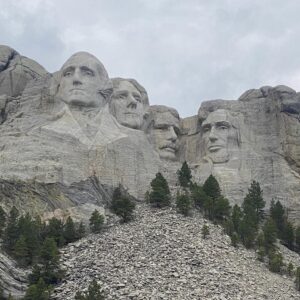
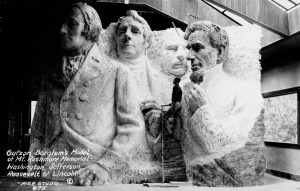 the sculpture to its current point. It isn’t exactly the sculpture Gutzon Borglum has imagined, because it was to have featured the presidents to their waists, but I think it is perfect as it stands today, from its four carved heads to the secret room, known as “The Hall of Records,” behind the structure, that no one is permitted to see without an act of Congress. That is something I would love to be allowed to see someday. As it stands, it too remains unfinished.
the sculpture to its current point. It isn’t exactly the sculpture Gutzon Borglum has imagined, because it was to have featured the presidents to their waists, but I think it is perfect as it stands today, from its four carved heads to the secret room, known as “The Hall of Records,” behind the structure, that no one is permitted to see without an act of Congress. That is something I would love to be allowed to see someday. As it stands, it too remains unfinished.

